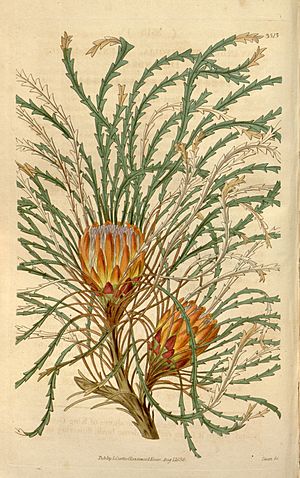Banksia tenuis facts for kids
Quick facts for kids Banksia tenuis |
|
|---|---|
 |
|
| Illustration from Curtis's Botanical Magazine | |
| Scientific classification | |
| Genus: |
Banksia
|
| Species: |
tenuis
|
| Synonyms | |
|
|
Banksia tenuis is a type of shrub that grows only in the southwest part of Western Australia. It has interesting leaves that can be deeply cut, saw-edged, or smooth. This plant produces golden-brown and cream-colored flowers. These flowers grow in groups of about fifty-five. After flowering, it forms smooth, egg-shaped seed pods called follicles.
Contents
What Does Banksia tenuis Look Like?
Banksia tenuis is a shrub that usually grows to about 1.5 meters (5 feet) tall. Sometimes, it can spread out like a mat, reaching up to 3 meters (10 feet) wide. Unlike some other plants, it does not form a special woody lump at its base called a lignotuber.
Its leaves are long and narrow, measuring between 60 and 260 millimeters (2.4 to 10.2 inches) in length. They are only 2 to 5 millimeters (0.08 to 0.2 inches) wide. The leaves grow on a stalk called a petiole, which can be up to 50 millimeters (2 inches) long. The leaves might be curved or bent. Some have up to twenty teeth on each side, making them look like a saw blade. Others have smooth edges.
The flowers are a mix of golden-brown and cream colors. They grow in groups, or "heads," with about forty-five to sixty-five flowers in each head. At the bottom of these flower heads are reddish-brown, egg-shaped leaves called involucral bracts. These bracts are about 40 to 45 millimeters (1.6 to 1.8 inches) long. Each individual flower has a part called the perianth, which is 27 to 33 millimeters (1.1 to 1.3 inches) long. The female part of the flower, called the pistil, is 23 to 31 millimeters (0.9 to 1.2 inches) long.
Banksia tenuis usually flowers from March to July. After the flowers fade, the plant produces smooth, egg-shaped seed pods. These pods, called follicles, are about 14 to 17 millimeters (0.55 to 0.67 inches) long.
How Banksia tenuis Got Its Name
This plant was first officially described in 1810 by a botanist named Robert Brown. He named it Dryandra tenuifolia. He published his description in a scientific journal called the Transactions of the Linnean Society of London.
Later, in 1996, another scientist named Alex George identified two different types, or varieties, of Dryandra tenuifolia:
- Dryandra tenuifolia var. reptans: This type is a low-growing shrub that spreads along the ground. Its leaves are mostly smooth-edged or have small teeth only near the tip.
- Dryandra tenuifolia var. tenuifolia: This type is a bushier, more upright shrub. Its leaves are deeply cut or saw-edged for most of their length.
In 2007, a big change happened in how these plants were classified. Scientists Austin Mast and Kevin Thiele moved all Dryandra species into the Banksia group. This meant Dryandra tenuifolia became Banksia tenuis. The two varieties also changed names to reptans and tenuis under the Banksia genus.
The name Banksia tenuifolia had already been used for a different plant, which is now known as Hakea sericea. Because of this, Mast and Thiele had to pick a new name for our plant. They chose "tenuis." This name comes from the Latin word tenuis, which means "thin." It refers to the plant's narrow leaves.
Where Banksia tenuis Grows
Banksia tenuis grows in a special type of shrubland found in Western Australia called kwongan. This plant is found in many places between Darkan, Williams, and the Cape Arid National Park.
The variety called tenuis grows between Kamballup in the Stirling Range National Park and Cape Arid. The other variety, reptans, is found between Darkan, Williams, and Jerramungup.
Future of Banksia tenuis
Scientists have studied how climate change might affect this plant. They found that the areas where Banksia tenuis can grow might shrink a lot by the year 2080. Depending on how much the climate changes, its habitat could become 30% to 80% smaller.
Is Banksia tenuis Endangered?
The good news is that Banksia tenuis and both of its varieties are currently considered "not threatened." This classification is given by the Western Australian Government's Department of Parks and Wildlife.

